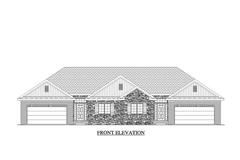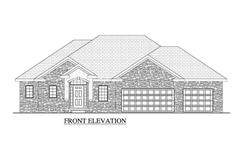Planning a Pantry? 9 Questions to ask
Planning a Pantry? 9 Questions to ask
We get a lot of requests for walk-in pantries as part of house designs. Here's a great article on 9 things to think about from Houzz.com.
9 Questions to Ask to Bypass Blunders
Some pantry design dilemmas won’t seem obvious at the time of planning but may become apparent at a later date when the installation is complete. Doors that open inwards on to shelving, badly arranged racks and compartments, small pigeonholes that won’t fit appliances, no hooks or hangers for napery and aprons, and poorly positioned lighting are all mistakes that can be circumvented. Use this quick guide to address the most obvious blunders before they happen. The suggestions may also inspire you to include some fresh ideas in your own plans.
1. Which way will the door open?
A common mistake when planning a pantry is fitting a door that gets in the way. When space is at a premium, the best options are sliding doors or concertina doors. An outward opening door gives more room for pantry shelves and is the next best option – but only if there is plenty of space outside the pantry to swing the door wide. A door that opens inwards can work but be aware it might make an already small space smaller. It can also compromise the space behind the door of your pantry, limiting the amount of stuff you can store there.
2. Will there be enough light?
Another typical mistake made when people are building their pantries is to have either poor lighting in the pantry or none at all. Your pantry will more than likely be built without a window, or if it does have a window, it may only be small. One way to make sure that you have enough light in there is to install quality LED lighting, or if your home is a single floor dwelling, put in a skylight. Also, the light switch should be reachable and in an accessible spot by the pantry door.
3. How can top shelves be accessed?
There is no point in planning a pantry with floor-to-ceiling storage if you can’t access the items on the top shelf. If your walk-in pantry is large enough, park a ladder on a sliding rail to access the home wares you rarely need, storing the trays and dishes you regularly use further down. If your pantry is small, store a stepladder in a handy spot for easy access. There are also inexpensive plastic single steps that can be purchased at discount stores, and these can be folded flat and hung up on a hook.
A brilliant idea for knowing what is on the upper shelves of your pantry without clambering up a stepladder is to install glass shelving or wire racks on the upper levels. Immediately you can check what is up high by casting your gaze to the ceiling.
4. What budget materials can be used to get a designer look?
A walk-in pantry doesn’t need to be fancy (it is, after all, behind a door and not on view), but nonetheless the shelves and cabinets should be made of a sturdy material with a finish that complements the rest of the kitchen. Solid, polished timber shelves or powder-coated metal racks are attractive options, however a cheaper alternative is engineered wood. Ply is one of the best low-cost engineered woods available. It is extremely strong and looks very contemporary, especially when it is left in its raw state or given a light stain.
Plywood shelves look especially smart when the surfaces have been laminated black, white or with a color, and the ply edges left exposed. This imbues any carpentry made from ply with a simple Scandinavian or Japanese aesthetic.
5. Will the position of the pantry aid or hinder kitchen traffic and, more importantly, cooking?
You not only need your pantry well illuminated, you also need to get in and out of your pantry quickly when cooking. If the pantry is positioned in such a way as to hinder the flow of kitchen traffic, you’ll have to walk too far to grab essential ingredients when whipping up a meal. For that reason, it’s important your pantry is near where you are preparing food. Also consider the process of stocking your pantry and where it is in relation to benches and tables in the kitchen. A kitchen bench top that is just outside a pantry will prove to be convenient for setting down groceries. Its close proximity also makes using it as a sorting station from which to fill pantry shelves extremely handy.
6. How will the shelves be arranged so that common items are easy to see?
Obviously put the items you use the most on the shelves that are in front of you when you walk into the pantry. Make sure the shelves are not too deep, and that you can see everything at once by placing smaller items at the front and larger items at the back. Heavy crockery and tableware can be stored on shelves that are wider and lower down.
A common error is to line the pantry with shelves from top to bottom with no break. A small and wider shelf at bench-height will not only fit larger, taller items or appliances, such as mixers, blenders, toasters or even microwaves, but also act as an extra server when preparing food.
7. Does the pantry need some special features?
It’s really only at the planning stage that you can incorporate special features that will become permanent but useful fixtures in your walk-in pantry. Some of these could include pull-out baskets for root vegetables, narrow pigeonholes for large platters and spice or wine racks.
8. How can free wall space be used effectively without overcrowding the pantry?
Every spare bit of space can be used to solve a storage problem and a pantry wall fee of shelving is no different. Whatever you decide to do with it, keep it simple – and flat. Some ideas include hanging up some hooks for aprons and utensils; or sticking a giant planner or calendar on the wall and filling it in with events and important dates for everyone in the household to see. A chalkboard painted on a section of the wall could also serve this purpose.
9. What and where will larger items be stored?
It’s a misconception that the walk-in pantry will only hold grocery items. Many appliances and cookware dishes and pans are kept in the pantry instead of a kitchen drawer or cabinet, mostly because it’s easier to access them. To accommodate these bulky items, create some large but uniformed pigeonholes.























